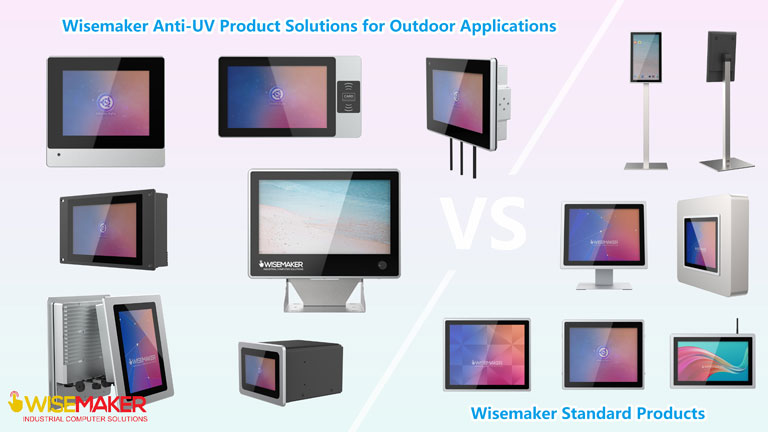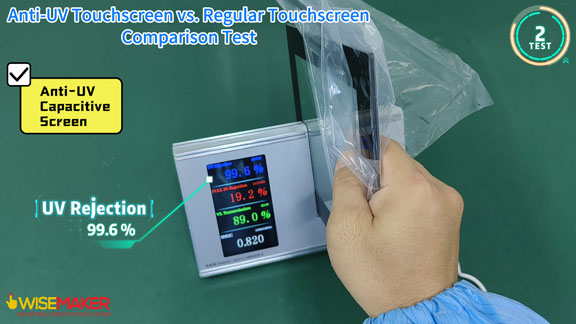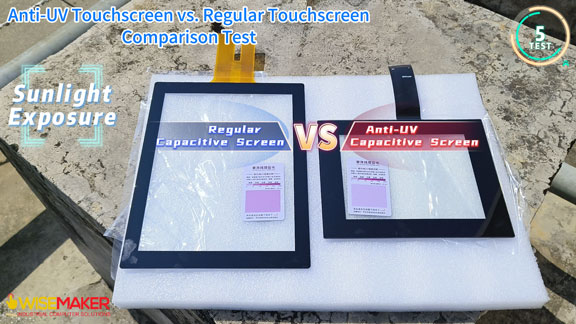Anti-UV Touchscreen vs. Regular Touchscreen Comparison Test
Over the past period, we’ve customized many outdoor Panel PC and display projects for our customers. One thing these cases all have in common is that they’re designed for outdoor environments, where every external component must be UV-resistant and aging-proof. Besides the UV-treated housing surface, the key display and touch areas also need to achieve UV protection.
But how can we tell the difference between a UV-resistant and a non-UV-resistant screen? Obviously, it’s not something you can distinguish just by looking at it.
To give everyone a more direct idea, we ran a comparison using three different methods — a spectrum transmission meter, a UV illumination light, and outdoor sunlight exposure — to test the difference between our regular touchscreens and UV-resistant ones.
For the test, we used Wisemaker 12.1-inch standard capacitive touchscreen and an 8.4-inch UV-resistant capacitive touchscreen, along with a professional spectrum transmission meter, a 365nm UV lamp, and UV test cards.
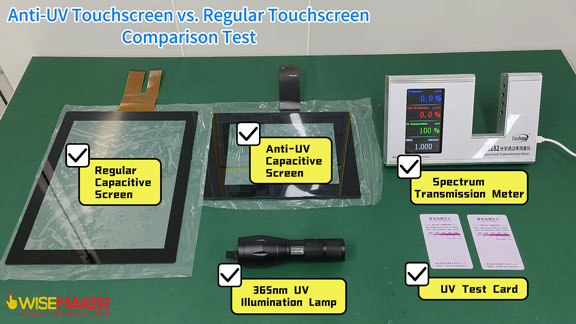
1. Spectrum Transmission Measurement Comparison
1.1 We first removed the front and back protective films from the regular capacitive touchscreen and placed it into the spectrum transmission meter’s testing slot. The result clearly showed that the UV blocking rate of the standard capacitive touchscreen was only 19.1%.
1.2 Similarly, after removing the front and back protective films from the UV-resistant capacitive touchscreen and placing it into the spectrum transmission meter’s testing slot, the result clearly showed a UV blocking rate of 99.6% for the UV-resistant touchscreen.
2. Comparison Using a 365nm UV Lamp and UV Test Cards
2.1 After removing the front protective film from the regular capacitive touchscreen, we placed two UV test cards on the screen surface and exposed them to the 365nm UV lamp. Both test cards changed color at the same speed and to the same depth, confirming that the cards were working properly.
2.2 We then placed one UV test card on the back of the capacitive touchscreen, while keeping the other on the front. When exposed to the UV lamp, we observed that both test cards changed color at almost the same speed and to a similar depth.
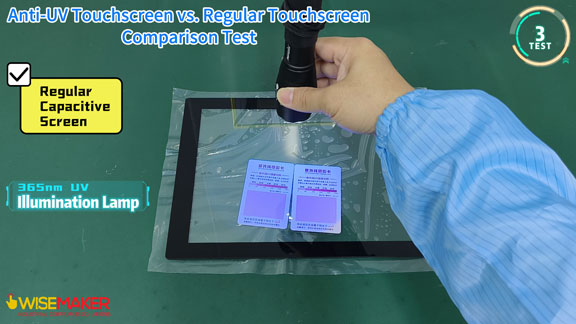
2.3 After removing the front protective film from the UV-resistant capacitive touchscreen, we placed two UV test cards on the screen surface and exposed them to the UV lamp. Both test cards changed color at the same speed and depth, confirming that the test cards were working properly.
2.4 We placed one UV test card on the back of the UV-resistant capacitive touchscreen and kept the other on the front. When exposed to the UV lamp, over time we observed that the card on the back stayed completely white, while the card on the front quickly turned purple and remained that way.
This step clearly shows the difference in UV resistance between the two capacitive touchscreens.
3. Outdoor Sunlight Exposure Test
We also conducted a real-world comparison by exposing the screens to direct sunlight outdoors.
3.1 First, we placed two UV test cards under direct sunlight. Both cards changed color at the same speed and to the same depth, confirming that the test cards were working properly.
3.2 We placed the two UV test cards on the back of each touchscreen. During the exposure, we clearly saw that the card under the regular capacitive touchscreen stayed purple, while the card under the UV-resistant touchscreen gradually lightened within a few seconds and then stayed unchanged.
This step of the experiment further highlighted the real-world UV resistance of the two touchscreens.
It's worth noting that our UV-resistant capacitive touchscreens are built to automotive-grade standards, blocking over 99% of UV light in the 365nm wavelength range. They also offer long-lasting durability, withstand extreme temperatures, and resist yellowing over time.
Note:
Sunlight is a complex spectrum that includes both visible and invisible light. The invisible part includes ultraviolet (UV) and infrared (IR) light. Within the UV range, there are short-wave UV (UV-C, 250–280 nm, which barely reaches the ground), medium-wave UV (UV-B, 280–315 nm), and long-wave UV (UV-A, 315–400 nm).
